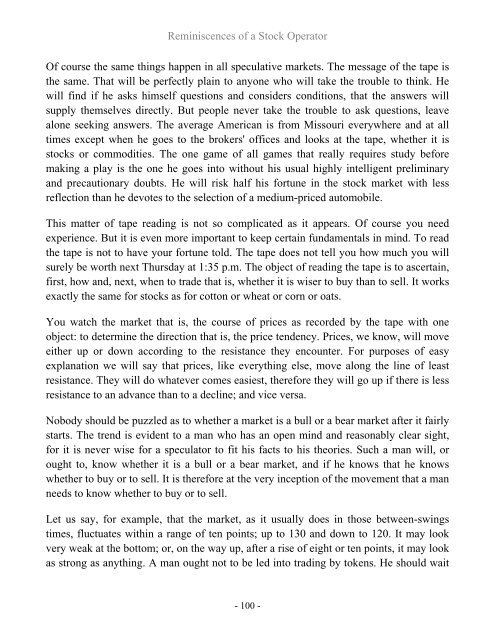Create successful ePaper yourself
Turn your PDF publications into a flip-book with our unique Google optimized e-Paper software.
Reminiscences of a Stock Operator<br />
Of course the same things happen in all speculative markets. The message of the tape is<br />
the same. That will be perfectly plain to anyone who will take the trouble to think. He<br />
will find if he asks himself questions and considers conditions, that the answers will<br />
supply themselves directly. But people never take the trouble to ask questions, leave<br />
alone seeking answers. The average American is from Missouri everywhere and at all<br />
times except when he goes to the brokers' offices and looks at the tape, whether it is<br />
stocks or commodities. The one game of all games that really requires study before<br />
making a play is the one he goes into without his usual highly intelligent preliminary<br />
and precautionary doubts. He will risk half his fortune in the stock market with less<br />
reflection than he devotes to the selection of a medium-priced automobile.<br />
This matter of tape reading is not so complicated as it appears. Of course you need<br />
experience. But it is even more important to keep certain fundamentals in mind. To read<br />
the tape is not to have your fortune told. The tape does not tell you how much you will<br />
surely be worth next Thursday at 1:35 p.m. The object of reading the tape is to ascertain,<br />
first, how and, next, when to trade that is, whether it is wiser to buy than to sell. It works<br />
exactly the same for stocks as for cotton or wheat or corn or oats.<br />
You watch the market that is, the course of prices as recorded by the tape with one<br />
object: to determine the direction that is, the price tendency. Prices, we know, will move<br />
either up or down according to the resistance they encounter. For purposes of easy<br />
explanation we will say that prices, like everything else, move along the line of least<br />
resistance. They will do whatever comes easiest, therefore they will go up if there is less<br />
resistance to an advance than to a decline; and vice versa.<br />
Nobody should be puzzled as to whether a market is a bull or a bear market after it fairly<br />
starts. The trend is evident to a man who has an open mind and reasonably clear sight,<br />
for it is never wise for a speculator to fit his facts to his theories. Such a man will, or<br />
ought to, know whether it is a bull or a bear market, and if he knows that he knows<br />
whether to buy or to sell. It is therefore at the very inception of the movement that a man<br />
needs to know whether to buy or to sell.<br />
Let us say, for example, that the market, as it usually does in those between-swings<br />
times, fluctuates within a range of ten points; up to 130 and down to 120. It may look<br />
very weak at the bottom; or, on the way up, after a rise of eight or ten points, it may look<br />
as strong as anything. A man ought not to be led into trading by tokens. He should wait<br />
- 100 -


